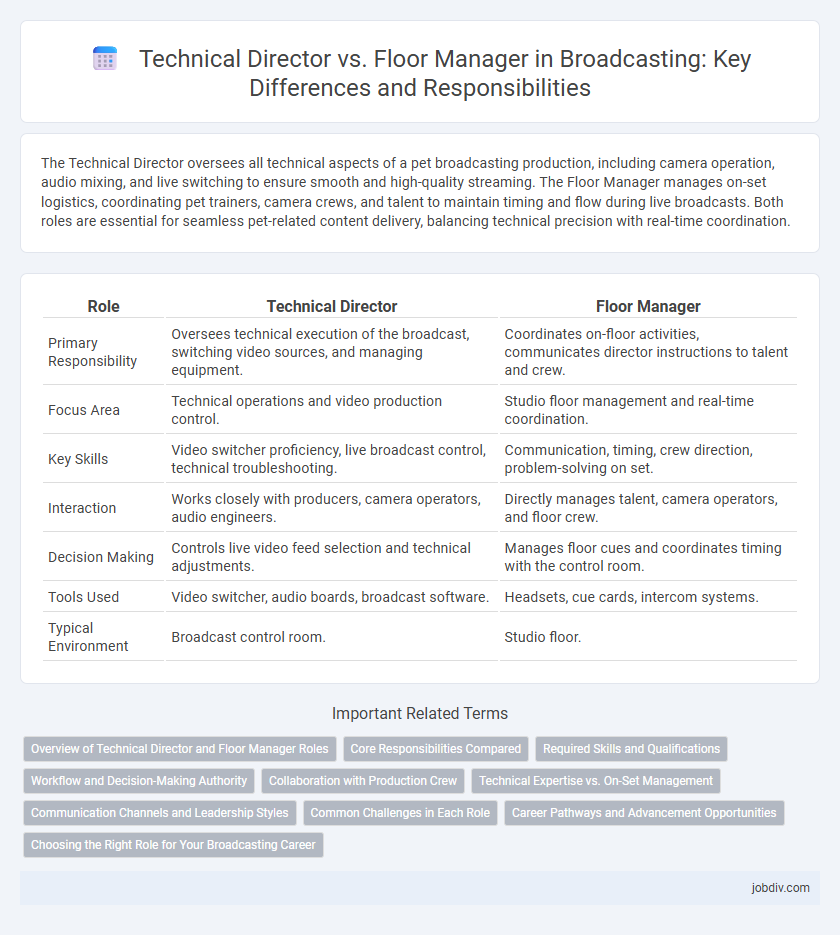The Technical Director oversees all technical aspects of a pet broadcasting production, including camera operation, audio mixing, and live switching to ensure smooth and high-quality streaming. The Floor Manager manages on-set logistics, coordinating pet trainers, camera crews, and talent to maintain timing and flow during live broadcasts. Both roles are essential for seamless pet-related content delivery, balancing technical precision with real-time coordination.
Table of Comparison
| Role | Technical Director | Floor Manager |
|---|---|---|
| Primary Responsibility | Oversees technical execution of the broadcast, switching video sources, and managing equipment. | Coordinates on-floor activities, communicates director instructions to talent and crew. |
| Focus Area | Technical operations and video production control. | Studio floor management and real-time coordination. |
| Key Skills | Video switcher proficiency, live broadcast control, technical troubleshooting. | Communication, timing, crew direction, problem-solving on set. |
| Interaction | Works closely with producers, camera operators, audio engineers. | Directly manages talent, camera operators, and floor crew. |
| Decision Making | Controls live video feed selection and technical adjustments. | Manages floor cues and coordinates timing with the control room. |
| Tools Used | Video switcher, audio boards, broadcast software. | Headsets, cue cards, intercom systems. |
| Typical Environment | Broadcast control room. | Studio floor. |
Overview of Technical Director and Floor Manager Roles
A Technical Director in broadcasting oversees the technical aspects of a production, including camera operations, video switching, and equipment management to ensure seamless live or recorded broadcasts. A Floor Manager coordinates on-set activities, communicates between the director and crew, and manages talent movement to maintain smooth workflow during production. Both roles are essential for synchronizing technical execution and live direction, optimizing broadcast quality and efficiency.
Core Responsibilities Compared
The Technical Director manages the broadcast's visual and audio elements by overseeing camera feeds, video switching, and technical equipment to ensure seamless production quality. The Floor Manager coordinates on-set activities, directing camera placements, talent movements, and crew communication to maintain smooth real-time operations during filming. Both roles are essential for live broadcasts, with the Technical Director focused on technical execution and the Floor Manager ensuring operational coordination on the studio floor.
Required Skills and Qualifications
Technical Directors in broadcasting require advanced technical skills in video switching, signal flow, and live production equipment, often holding certifications in broadcast technology or media production. Floor Managers need strong communication, organizational skills, and the ability to coordinate talent and crew in real-time, typically possessing experience in stage management or production coordination. Both roles demand quick decision-making abilities and a deep understanding of live broadcast workflows to ensure seamless program execution.
Workflow and Decision-Making Authority
The Technical Director oversees the overall technical workflow in a broadcast, managing video switchers, graphics, and live feeds to ensure seamless production quality. The Floor Manager operates on the studio floor, coordinating on-camera talent and crew, relaying director's instructions to maintain real-time execution. Decision-making authority rests primarily with the Technical Director on technical and broadcast elements, while the Floor Manager handles immediate logistical and performance-related decisions during the broadcast.
Collaboration with Production Crew
The Technical Director coordinates the visual and technical elements, ensuring seamless integration of video feeds, graphics, and camera work during live broadcasts. The Floor Manager acts as the primary liaison between the control room and on-set talent, conveying producer and director instructions while managing timing and cues. Effective collaboration between these roles is crucial for synchronizing live production elements and maintaining smooth, real-time communication across the entire production crew.
Technical Expertise vs. On-Set Management
A Technical Director in broadcasting is responsible for managing the technical aspects of a production, including operation of video switchers, signal flow, and ensuring seamless integration of graphics and live feeds. In contrast, a Floor Manager focuses on on-set management, coordinating talent, crew, and timing to maintain smooth communication between the control room and the production floor. While the Technical Director requires in-depth knowledge of broadcast technology and equipment, the Floor Manager excels in real-time problem-solving and directing physical logistics during live broadcasts.
Communication Channels and Leadership Styles
Technical Directors in broadcasting coordinate complex communication channels by relaying signals and commands between control rooms and on-air talent to ensure seamless production flow. Floor Managers lead with direct, on-the-ground communication, managing performers and crew through immediate verbal instructions and non-verbal cues within the studio environment. Both roles require adaptive leadership styles, with Technical Directors emphasizing centralized command and Floor Managers fostering real-time responsiveness and team coordination.
Common Challenges in Each Role
Technical Directors face common challenges such as managing complex video switchers and coordinating live broadcast feeds to ensure seamless production quality. Floor Managers often struggle with real-time communication between the control room and on-set talent, maintaining schedule adherence, and handling unexpected changes during live shoots. Both roles require quick decision-making and effective problem-solving to navigate technical glitches and dynamic production environments.
Career Pathways and Advancement Opportunities
Technical Directors in broadcasting typically advance by gaining expertise in video and audio equipment, signal flow, and live production technology, often progressing to senior technical management or engineering roles. Floor Managers build careers through mastering on-set coordination, communication, and timing, frequently moving into production management or directing positions. Both pathways require strong leadership, but Technical Directors tend to focus on technical innovation, whereas Floor Managers emphasize crew coordination and content delivery.
Choosing the Right Role for Your Broadcasting Career
Technical Directors oversee the broadcast's technical aspects, including camera switches, video formats, and live feeds, ensuring seamless production quality. Floor Managers coordinate studio floor activities, managing talent, props, and communication between the director and on-set crew to maintain smooth operations during live broadcasts. Choosing between these roles depends on whether you prefer hands-on technical control or logistical coordination within the dynamic broadcasting environment.
Technical Director vs Floor Manager Infographic

 jobdiv.com
jobdiv.com